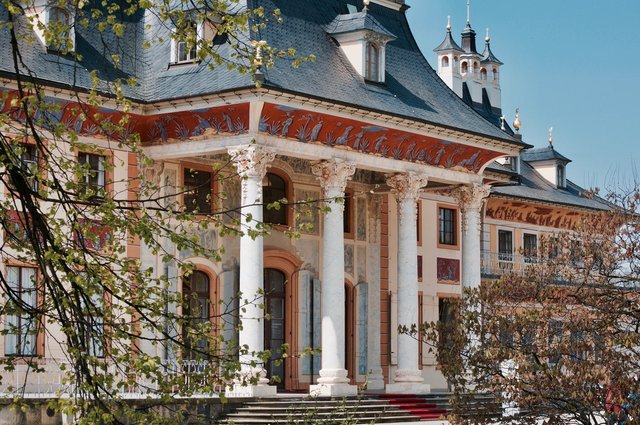Good morning Steemers, what I would like to introduce you today is located near your home town Dresden .... it is the Pillnitz Palace ... a must for every visitor of our beautiful country ....

The Pillnitz Palace from the 18th century is located on the Elbe in the former village of Pillnitz, which is now part of Dresden.

It consists essentially of three parts, the water palace on the Elbe, the mountain palace opposite the slope, and the New Palace, which is connected to the east side. The baroque pleasure garden enclosed by the buildings is complemented by a surrounding castle park.

Pillnitz Palace is an excellent example of the 18th century Chinamode. Shortly after its completion, a prince's meeting took place here in 1791, the result of which, as a Pillnitz Declaration, entered into world history.

While the gardens at the old castle were only for the economy, they were intensively expanded and redesigned by the Saxon electors. Countess of Cosel had the hedge-plants planted in 1712. Between the mountain and the water palace the baroque pleasure garden with fountains and bosquets was built, above the mountain palace around 1723 the large palace garden with its twelve tree rows.

In 1723 August the Strong made a new Gotteshaus, the wine church "Zum Heiligen Geist", as a substitute for the chapel for the Protestant congregation of the village in the vineyard located east of the castle. Here as well, the construction plan was in the hands of Matthew Daniel Pöppelmann. The dedication took place in 1725. In the church, the altar of the sculptor Johann Georg Kretzschmar, created in 1648, found a worthy place.

The English garden was built in the spring of 1778 on a land purchased in 1725 in the north-western part of the park. The artificially created landscape in the style of a natural scent comes without substantial decorations. Only a surviving head of Juno Ludovisi, a bronze cast of the ancient female head in the Roman spa museum, was placed in the 19th century on the island in the pond here.

In 1778, the English Garden and 1790 were the Chinese Garden. From 1874 to 1880 a coniferous plant with rare domestic and foreign conifers was created. This collection of plants from all over the world now comprises six contiguous gardens covering an area of 28 hectares.
So if you are once in Germany, Saxony or Dresden, do not miss this wonderfully designed facility. Particularly recommendable is a visit in the spring, as at that time also the impressive camellia is in full bloom. The Pillnitzer Camellia is one of the oldest camellias in Europe. Meanwhile, over 230 years old, it has reached a height of about 8.90 meters and a diameter of almost 11 meters. During its flowering period from February to April, up to 35,000 flowers appear. These are of crimson color, unfilled and without fragrance. The plant is located in the park of Pillnitz Castle and is protected from frost by a mobile greenhouse.
So if you are here ... look with pure ...
Photos by @HomeAtPictures
The text was partly taken over by https://de.wikipedia.org/wiki/Schloss_Pillnitz
If you want to learn more about me or my pictures then just follow me here. Many thanks
Excellent photo's. The one of the church would make for a great jigsaw puzzle.
Thanks themagus